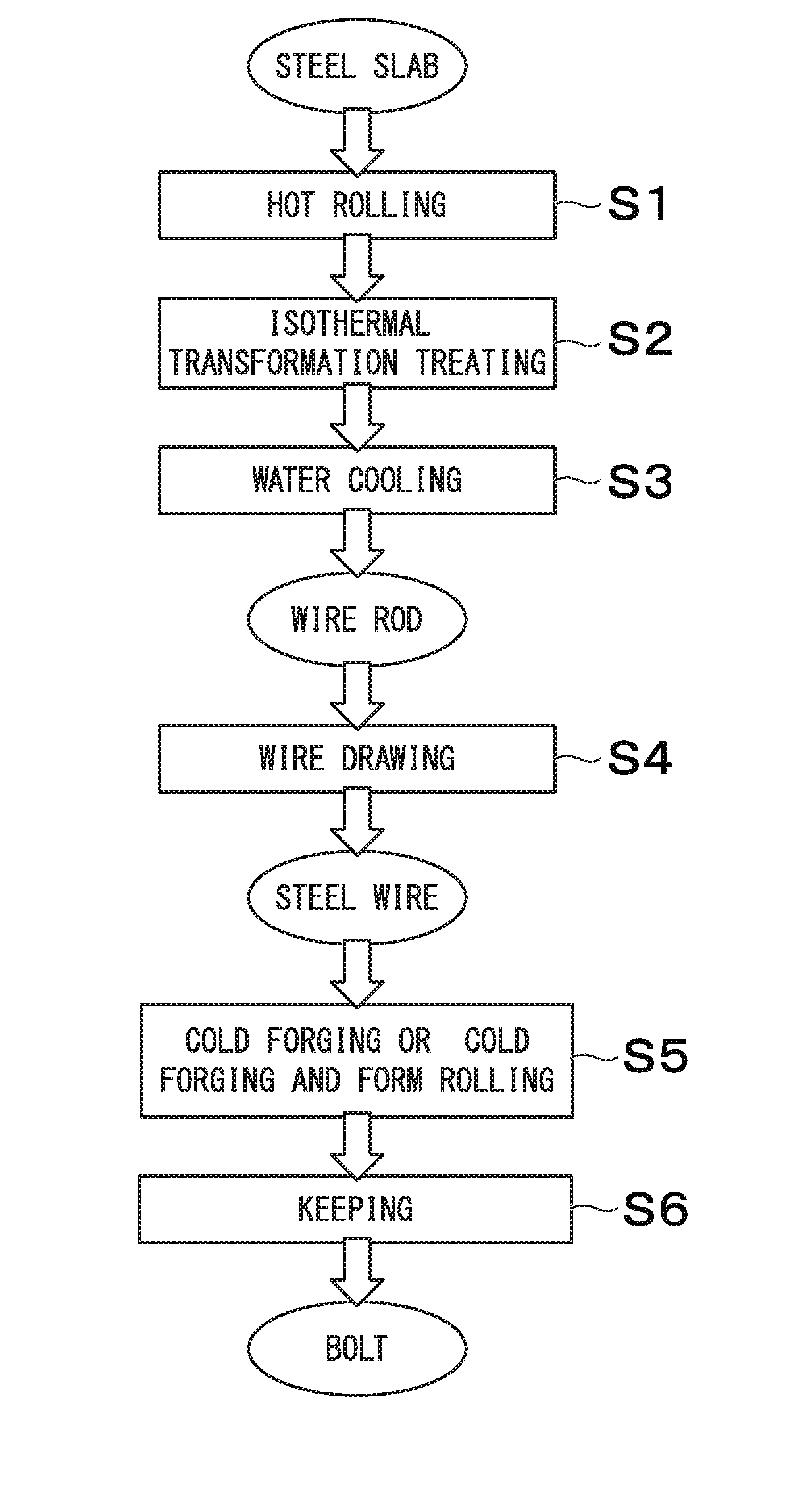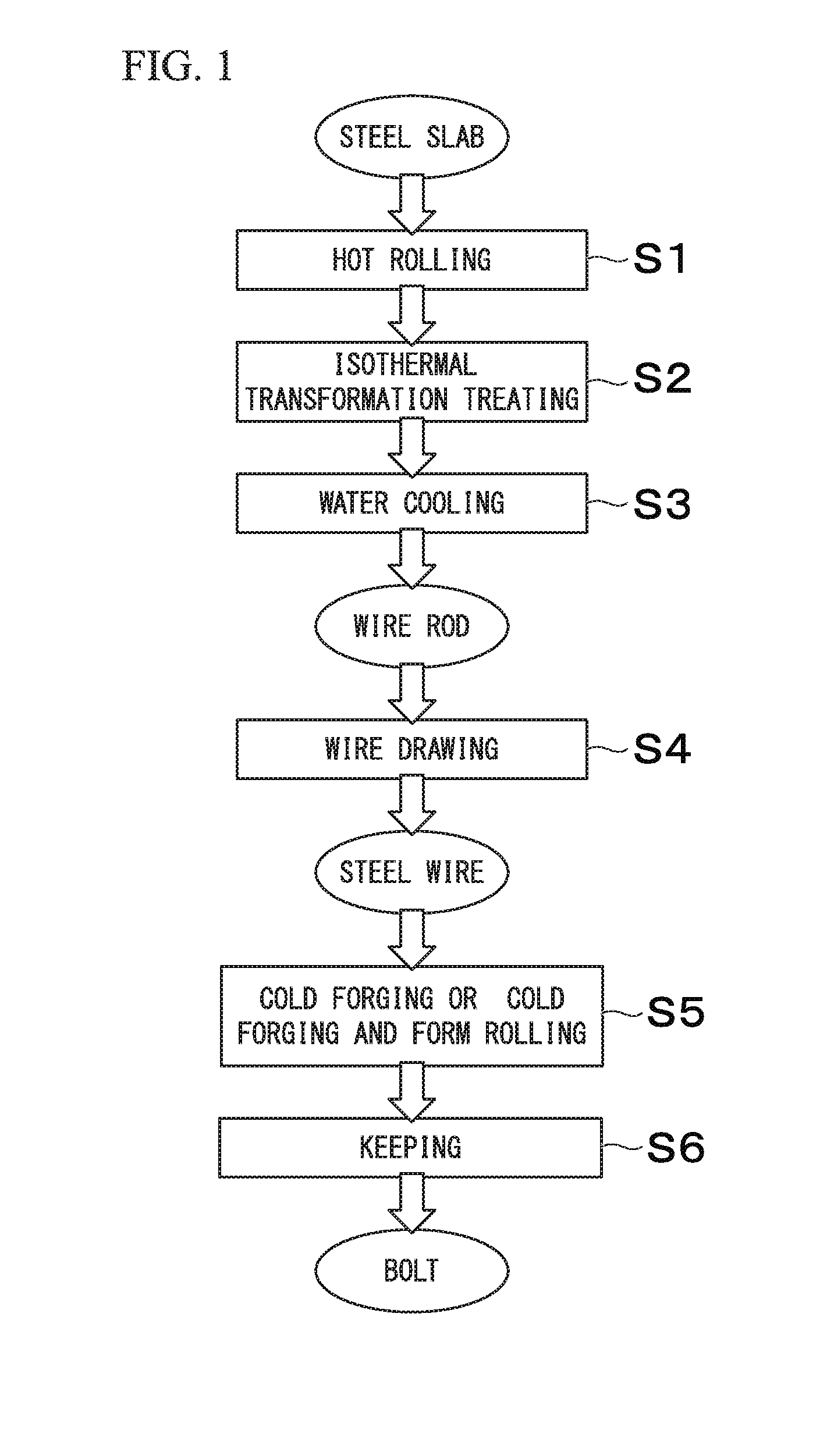A WIRE ROD HAVING TENSILE STRENGTH OF 950 TO 1600MPa FOR MANUFACTURING A STEEL WIRE FOR A PEARLITE STRUCTURE BOLT, A STEEL WIRE HAVING TENSILE STRENGTH OF 950 TO 1600MPa FOR A PEARLITE STRUCTURE BOLT, A PEARLITE STRUCTURE BOLT, AND MANUFACTURING METHOD FOR THE SAME
a technology of pearlite structure and steel wire, which is applied in the field of wire rods, can solve the problems of insufficient enhancement of embrittlement resistance, method cannot create a radical solution, and the use of high-strength bolts is restricted, and achieve excellent cold workability of bolts, excellent hydrogen embrittlement resistance, and high strength
- Summary
- Abstract
- Description
- Claims
- Application Information
AI Technical Summary
Benefits of technology
Problems solved by technology
Method used
Image
Examples
example 1
[0136]Steel pieces having chemical composition disclosed in Table 1 was heated and hot rolled to obtain wire rods, and the wire rods were isothermal transformation treated and subsequently cooled. At that time, cooling start temperature for all of example wire rods and comparative example wire rods was 450° C., and cooling stop temperature for all of example wire rods and comparative example wire rods was 280° C. The average block size, average lamellar spacing, and area ratio of pearlite at the surface part (the area from a surface of the wire rod to a depth of 4.5 mm) of the example wire rods and the comparative example wire rods were measured. The average block size of the pearlite block at the surface part of the wire rod was measured by, at first, measuring an average value of a circle equivalent diameter of the pearlite block at a depth of 4.5 mm from the surface in transverse section of the wire rod at 8 points at intervals of 45 with EBSD device, and then, calculating the av...
example 2
[0141]Steel wires were manufactured by wire drawing with total reduction of area of 5 to 70% the example wire rod 1 to 7 and the comparative example wire rod 1 to 7 shown in Table 2, and the limit compressibility of the steel wires were manufactured. The results are shown in Table 3.
[0142]The limit compressibility is an index indicating cold workability. The limit compressibility was measured by the following procedure. Steel wires after wire drawing were machined to manufacture test pieces having a diameter D and a height 1.5 D. Edge surfaces of the test pieces were constrained and compressed by a metal mold having concentric grooves. The maximum compression ratio which did not cause crack was assumed as the limit compressibility of the test piece.
[0143][Table 3]
[0144]In the comparative example steel wire 1, 3, 4, 5, and 6 in which the average block size at the surface part of the steel wire was out of the range of the present invention, and in the comparative example steel wire 7 ...
example 3
[0145]The example steel wire 1 to 7 and the comparative example steel wire 1 to 9 shown in the Table 3 were cold forged to be flange bolts. After the working, the bolts were kept in 300 to 450° C. to manufacture bolts. Temperature keeping time for all bolts was 30 minutes. The measuring results of tensile strength, proof stress ratio, and hydrogen embrittlement resistance of the shaft parts of the bolts are shown in Table 4.
[0146]Evaluation of hydrogen embrittlement resistance was performed by the following procedure. At first, 0.5 ppm of diffusible hydrogen was included in the test pieces by electrolytic hydrogen charging the test pieces. Next, the test pieces were Cr plated in order to prevent the hydrogen from discharging from the test pieces to atmosphere. Thereafter, loads which were 90% of the maximum tensile loads of the test pieces were loaded to the test pieces in atmosphere. A test piece in which crack did not occur after 100 h of loading was determined as a test piece hav...
PUM
| Property | Measurement | Unit |
|---|---|---|
| Temperature | aaaaa | aaaaa |
| Temperature | aaaaa | aaaaa |
| Temperature | aaaaa | aaaaa |
Abstract
Description
Claims
Application Information
 Login to View More
Login to View More - R&D
- Intellectual Property
- Life Sciences
- Materials
- Tech Scout
- Unparalleled Data Quality
- Higher Quality Content
- 60% Fewer Hallucinations
Browse by: Latest US Patents, China's latest patents, Technical Efficacy Thesaurus, Application Domain, Technology Topic, Popular Technical Reports.
© 2025 PatSnap. All rights reserved.Legal|Privacy policy|Modern Slavery Act Transparency Statement|Sitemap|About US| Contact US: help@patsnap.com


